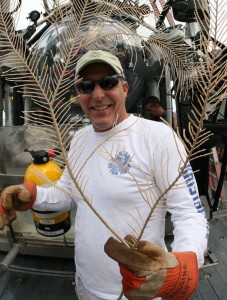NSU Newsroom
SharkBytes
Horizons
This version of NSU News has been archived as of February 28, 2019. To search through archived articles, visit nova.edu/search. To access the new version of NSU News, visit news.nova.edu.
This version of SharkBytes has been archived as of February 28, 2019. To search through archived articles, visit nova.edu/search. To access the new version of SharkBytes, visit sharkbytes.nova.edu.
Halmos Professor Travels to Europe to Research Crinoid Evolution
Charles Messing, Ph.D., professor at NSU’s Halmos College of Natural Sciences and Oceanography, recently returned from Europe, where he examined museum collections and consulted with paleontologists about incorporating Mesozoic fossil crinoids (sea lilies and feather stars) into phylogenetic trees of crinoid evolution.
Such trees are currently based chiefly on DNA data from living species. Crinoids are echinoderms—relatives of sea stars and sea urchins—the only living group that bears a stalk. Messing is developing a spreadsheet that lists the different characters and their various states for a selection of fossils and living species. Once complete, the data will be entered into a computer program that will generate a phylogenetic tree and provide the best estimate of their pattern of evolution.
Messing visited colleagues in Basel, Switzerland, for Jurassic crinoids; Ingelfingen, Germany, for Triassic crinoids; and Maastricht, Netherlands, for Cretaceous crinoids—research that covers about 180 million years of crinoid history.
Messing’s study, “When Physical Form and DNA Collide: Resolving the Evolutionary Tree of Crinoidea,” is funded by NSU’s President’s Faculty Research and Development Grant.
“By including fossil species, this trip represents a new direction for my research and may generate new opportunities for student research as well,” said Messing, whose students focusing on crinoids have previously accompanied him to international conferences, deep-sea expeditions in Honduras and the Gulf of Mexico, and a scuba expedition to Indonesia.
